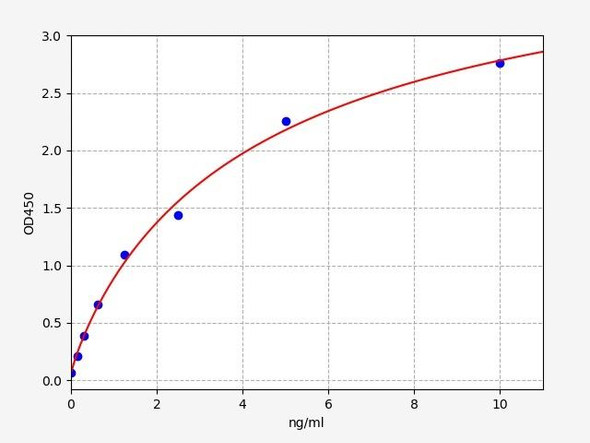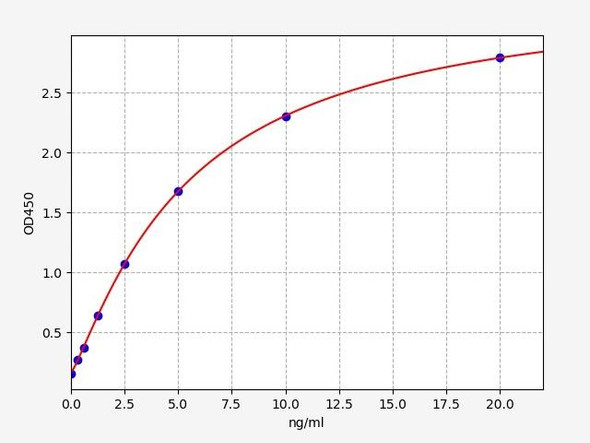Human Immunology ELISA Kits 1
Human HABP1/C1QBP (Hyaluronan Binding Protein 1) CLIA Kit (HUES01284)
- SKU:
- HUES01284
- Product Type:
- ELISA Kit
- ELISA Type:
- CLIA Kit
- Size:
- 96 Assays
- Sensitivity:
- 18.75pg/mL
- Range:
- 31.25-2000pg/mL
- ELISA Type:
- Sandwich
- Synonyms:
- C1QBP, GC1QBP, SF2p32, gC1Q-R, gC1qR, p32
- Reactivity:
- Human
- Sample Type:
- Serum, plasma and other biological fluids
- Research Area:
- Immunology
Description
| Assay type: | Sandwich |
| Format: | 96T |
| Assay time: | 4.5h |
| Reactivity: | Human |
| Detection method: | Chemiluminescence |
| Detection range: | 31.25-2000 pg/mL |
| Sensitivity: | 18.75 pg/mL |
| Sample volume: | 100µL |
| Sample type: | Serum, plasma and other biological fluids |
| Repeatability: | CV < 15% |
| Specificity: | This kit recognizes Human HABP1/C1QBP in samples. No significant cross-reactivity or interference between Human HABP1/C1QBP and analogues was observed. |
This kit uses Sandwich-CLIA as the method. The micro CLIA plate provided in this kit has been pre-coated with an antibody specific to Human HABP1/C1QBP. Standards or samples are added to the appropriate micro CLIA plate wells and combined with the specific antibody. Then a biotinylated detection antibody specific for Human HABP1/C1QBP and Avidin-Horseradish Peroxidase (HRP) conjugate are added to each micro plate well successively and incubated. Free components are washed away. The substrate solution is added to each well. Only those wells that contain Human HABP1/C1QBP, biotinylated detection antibody and Avidin-HRP conjugate will appear fluorescence. The Relative light unit (RLU) value is measured spectrophotometrically by the Chemiluminescence immunoassay analyzer. The RLU value is positively associated with the concentration of Human HABP1/C1QBP. The concentration of Human HABP1/C1QBP in the samples can be calculated by comparing the RLU of the samples to the standard curve.
| UniProt Protein Function: | C1QBP: a multifunctional and multicompartmental protein involved in inflammation and infection processes, ribosome biogenesis, regulation of apoptosis, transcriptional regulation and pre-mRNA splicing. Originally identified via its binding interactions with Splicing Factor (SF-2). Multiple, diverse binding partners of C1QBP were subsequently identified, including the globular heads of complement component C1q, hyaluronic acid, selected protein kinases, the tumor suppressor ARF, and multiple antigens of bacterial and viral origin. Overexpressed in a number of cancer cell types, and has been implicated in the Warburg effect, whereby cancer cells shift their metabolism from oxidative phosphorylation to glycolysis. Inhibits the Mitochondrial Permeability Transition (MPT) pore, possibly serving a protective function against damage from oxidative stress. Binding to C1q inhibits C1. In complex with cytokeratin-1/KRT1 is a high affinty receptor for kininogen-1/HMWK. The secreted form may enhance both extrinsic and intrinsic coagulation pathways. The cell surface form may require docking with transmembrane proteins for downstream signaling which might be specific for a cell-type or response. Belongs to the MAM33 family. |
| UniProt Protein Details: | Protein type:Motility/polarity/chemotaxis; Receptor, misc. ; Nucleolus; Mitochondrial Chromosomal Location of Human Ortholog: 17p13. 3 Cellular Component: cell surface; cytoplasm; cytosol; membrane; mitochondrion; nucleus; plasma membrane Molecular Function:adrenergic receptor binding; complement component C1q binding; hyaluronic acid binding; kininogen binding; mRNA binding; protein binding; transcription corepressor activity; transcription factor binding Biological Process: blood coagulation, intrinsic pathway; immune response; mature ribosome assembly; negative regulation of defense response to virus; negative regulation of interferon-gamma production; negative regulation of interleukin-12 production; negative regulation of nuclear mRNA splicing, via spliceosome; negative regulation of transcription from RNA polymerase II promoter; phosphoinositide 3-kinase cascade; positive regulation of apoptosis; positive regulation of cell adhesion; positive regulation of protein kinase B signaling cascade; regulation of complement activation |
| NCBI Summary: | The human complement subcomponent C1q associates with C1r and C1s in order to yield the first component of the serum complement system. The protein encoded by this gene is known to bind to the globular heads of C1q molecules and inhibit C1 activation. This protein has also been identified as the p32 subunit of pre-mRNA splicing factor SF2, as well as a hyaluronic acid-binding protein. [provided by RefSeq, Jul 2008] |
| UniProt Code: | Q07021 |
| NCBI GenInfo Identifier: | 730772 |
| NCBI Gene ID: | 708 |
| NCBI Accession: | Q07021. 1 |
| UniProt Secondary Accession: | Q07021,Q2HXR8, Q9NNY8, |
| UniProt Related Accession: | Q07021 |
| Molecular Weight: | 31,362 Da |
| NCBI Full Name: | Complement component 1 Q subcomponent-binding protein, mitochondrial |
| NCBI Synonym Full Names: | complement C1q binding protein |
| NCBI Official Symbol: | C1QBP |
| NCBI Official Synonym Symbols: | p32; HABP1; gC1qR; GC1QBP; SF2p32; gC1Q-R |
| NCBI Protein Information: | complement component 1 Q subcomponent-binding protein, mitochondrial |
| UniProt Protein Name: | Complement component 1 Q subcomponent-binding protein, mitochondrial |
| UniProt Synonym Protein Names: | ASF/SF2-associated protein p32; Glycoprotein gC1qBP; C1qBP; Hyaluronan-binding protein 1; Mitochondrial matrix protein p32; gC1q-R protein; p33 |
| Protein Family: | Complement component 1 Q subcomponent-binding protein |
| UniProt Gene Name: | C1QBP |
| UniProt Entry Name: | C1QBP_HUMAN |
As the RLU values of the standard curve may vary according to the conditions of the actual assay performance (e. g. operator, pipetting technique, washing technique or temperature effects), the operator should establish a standard curve for each test. Typical standard curve and data is provided below for reference only.
| Concentration (pg/mL) | RLU | Average | Corrected |
| 2000 | 54409 57033 | 55721 | 55693 |
| 1000 | 23689 24259 | 23974 | 23946 |
| 500 | 11885 10179 | 11032 | 11004 |
| 250 | 4977 5611 | 5294 | 5266 |
| 125 | 2776 2440 | 2608 | 2580 |
| 62.5 | 1391 1231 | 1311 | 1283 |
| 31.25 | 633 715 | 674 | 646 |
| 0 | 27 29 | 28 | -- |
Precision
Intra-assay Precision (Precision within an assay): 3 samples with low, mid range and high level Human HABP1/C1QBP were tested 20 times on one plate, respectively.
Inter-assay Precision (Precision between assays): 3 samples with low, mid range and high level Human HABP1/C1QBP were tested on 3 different plates, 20 replicates in each plate.
| Intra-assay Precision | Inter-assay Precision | |||||
| Sample | 1 | 2 | 3 | 1 | 2 | 3 |
| n | 20 | 20 | 20 | 20 | 20 | 20 |
| Mean (pg/mL) | 100.39 | 290.08 | 811.44 | 105.22 | 297.49 | 850.24 |
| Standard deviation | 8.95 | 27.47 | 53.72 | 12.25 | 23.77 | 67.51 |
| C V (%) | 8.92 | 9.47 | 6.62 | 11.64 | 7.99 | 7.94 |
Recovery
The recovery of Human HABP1/C1QBP spiked at three different levels in samples throughout the range of the assay was evaluated in various matrices.
| Sample Type | Range (%) | Average Recovery (%) |
| Serum (n=5) | 88-99 | 94 |
| EDTA plasma (n=5) | 94-110 | 101 |
| Cell culture media (n=5) | 94-108 | 101 |
Linearity
Samples were spiked with high concentrations of Human HABP1/C1QBP and diluted with Reference Standard & Sample Diluent to produce samples with values within the range of the assay.
| Serum (n=5) | EDTA plasma (n=5) | Cell culture media (n=5) | ||
| 1:2 | Range (%) | 92-105 | 84-96 | 92-104 |
| Average (%) | 100 | 91 | 99 | |
| 1:4 | Range (%) | 88-104 | 85-97 | 88-100 |
| Average (%) | 96 | 90 | 95 | |
| 1:8 | Range (%) | 87-99 | 103-119 | 99-114 |
| Average (%) | 94 | 110 | 107 | |
| 1:16 | Range (%) | 93-104 | 99-112 | 97-113 |
| Average (%) | 98 | 106 | 105 |
An unopened kit can be stored at 4°C for 1 month. If the kit is not used within 1 month, store the items separately according to the following conditions once the kit is received.
| Item | Specifications | Storage |
| Micro CLIA Plate(Dismountable) | 8 wells ×12 strips | -20°C, 6 months |
| Reference Standard | 2 vials | |
| Concentrated Biotinylated Detection Ab (100×) | 1 vial, 120 µL | |
| Concentrated HRP Conjugate (100×) | 1 vial, 120 µL | -20°C(shading light), 6 months |
| Reference Standard & Sample Diluent | 1 vial, 20 mL | 4°C, 6 months |
| Biotinylated Detection Ab Diluent | 1 vial, 14 mL | |
| HRP Conjugate Diluent | 1 vial, 14 mL | |
| Concentrated Wash Buffer (25×) | 1 vial, 30 mL | |
| Substrate Reagent A | 1 vial, 5 mL | 4°C (shading light) |
| Substrate Reagent B | 1 vial, 5 mL | 4°C (shading light) |
| Plate Sealer | 5 pieces | |
| Product Description | 1 copy | |
| Certificate of Analysis | 1 copy |
- Set standard, test sample and control (zero) wells on the pre-coated plate and record theirpositions. It is recommended to measure each standard and sample in duplicate. Note: addall solutions to the bottom of the plate wells while avoiding contact with the well walls. Ensuresolutions do not foam when adding to the wells.
- Aliquot 100 µL of standard solutions into the standard wells.
- Add 100 µL of Sample / Standard dilution buffer into the control (zero) well.
- Add 100 µL of properly diluted sample (serum, plasma, tissue homogenates and otherbiological fluids. ) into test sample wells.
- Cover the plate with the sealer provided in the kit and incubate for 90 min at 37 °C.
- Aspirate the liquid from each well, do not wash. Immediately add 100 µL of BiotinylatedDetection Ab working solution to each well. Cover the plate with a plate seal and gently mix. Incubate for 1 hour at 37 °C.
- Aspirate or decant the solution from the plate and add 350 µL of wash buffer to each welland incubate for 1-2 minutes at room temperature. Aspirate the solution from each well andclap the plate on absorbent filter paper to dry. Repeat this process 3 times. Note: a microplatewasher can be used in this step and other wash steps.
- Add 100 µL of HRP Conjugate working solution to each well. Cover with a plate seal andincubate for 30 min at 37 °C.
- Aspirate or decant the solution from each well. Repeat the wash process for five times asconducted in step 7.
- Add 100 µL of Substrate mixture solution to each well. Cover with a new plate seal andincubate for no more than 5 min at 37 °C. Protect the plate from light.
- Determine the RLU value of each well immediately.






